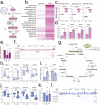p63 affects distinct metabolic pathways during keratinocyte senescence, evaluated by metabolomic profile and gene expression analysis
- PMID: 39543093
- PMCID: PMC11564703
- DOI: 10.1038/s41419-024-07159-7
p63 affects distinct metabolic pathways during keratinocyte senescence, evaluated by metabolomic profile and gene expression analysis
Abstract
Unraveling the molecular nature of skin aging and keratinocyte senescence represents a challenging research project in epithelial biology. In this regard, depletion of p63, a p53 family transcription factor prominently expressed in human and mouse epidermis, accelerates both aging and the onset of senescence markers in vivo animal models as well as in ex vivo keratinocytes. Nonetheless, the biochemical link between p63 action and senescence phenotype remains largely unexplored. In the present study, through ultrahigh performance liquid chromatography-tandem mass spectroscopy (UPLC-MS/MS) and gas chromatography/mass spectrometry (GC/MS) metabolomic analysis, we uncover interesting pathways linking replicative senescence to metabolic alterations during p63 silencing in human keratinocytes. Integration of our metabolomic profiling data with targeted transcriptomic investigation empowered us to demonstrate that absence of p63 and senescence share similar modulation profiles of oxidative stress markers, pentose phosphate pathway metabolites and lyso-glycerophospholipids, the latter due to enhanced phospholipases gene expression profile often under p63 direct/indirect gene control. Additional biochemical features identified in deranged keratinocytes include a relevant increase in lipids production, glucose and pyruvate levels as confirmed by upregulation of gene expression of key lipid synthesis and glycolytic enzymes, which, together with improved vitamins uptake, characterize senescence phenotype. Silencing of p63 in keratinocytes instead, translates into a blunted flux of metabolites through both glycolysis and the Krebs cycle, likely due to a p63-dependent reduction of hexokinase 2 and citrate synthase gene expression. Our findings highlight the potential role of p63 in counteracting keratinocyte senescence also through fine regulation of metabolite levels and relevant biochemical pathways. We believe that our research might contribute significantly to the discovery of new implications of p63 in keratinocyte senescence and related diseases.
© 2024. The Author(s).
Conflict of interest statement
Figures





References
-
- Hayflick L, Moorhead PS. The serial cultivation of human diploid cell strains. Exp Cell Res. 1961;25:585–621. - PubMed
MeSH terms
Substances
Grants and funding
- PNC-E3-2022-23683266/Ministry of Health, Italy | Agenzia Italiana del Farmaco, Ministero della Salute (Italian Medicines Agency)
- PNC-E3-2022-23683266/Ministero della Salute (Ministry of Health, Italy)
- IG 2019 - ID 22206; 2019-2023/Associazione Italiana per la Ricerca sul Cancro (Italian Association for Cancer Research)
LinkOut - more resources
Full Text Sources
Research Materials
Miscellaneous

